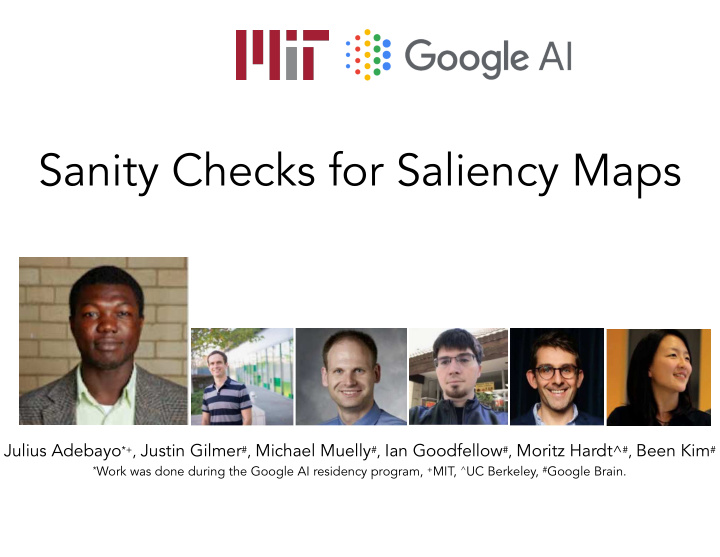



Sanity Checks for Saliency Maps Julius Adebayo *+ , Justin Gilmer # , Michael Muelly # , Ian Goodfellow # , Moritz Hardt ^ # , Been Kim # * Work was done during the Google AI residency program, + MIT, ^ UC Berkeley, # Google Brain.
Interpretability To use machine learning more responsibly .
Investigating post-training interpretability methods. Given a fixed model, find the evidence of prediction . � 3
Investigating post-training interpretability methods. A trained machine learning model (e.g., neural network) Junco Bird-ness Given a fixed model, find the evidence of prediction . Why was this a Junco bird? � 4
One of the most popular techniques: Saliency maps A trained machine learning model (e.g., neural network) Junco Bird-ness The promise: these pixels are the Caaaaan do! evidence of prediction. � 5
Sanity check question. A trained machine learning model (e.g., neural network) Junco Bird-ness The promise: these pixels are the evidence of prediction. � 6
Sanity check question. A trained machine learning model (e.g., neural network) Junco Bird-ness The promise: these pixels are the evidence of If so, when prediction changes, the explanation should change. prediction. Extreme case: If prediction is random, the explanation should REALLY change. � 7
Sanity check: When prediction changes, do explanations change? Saliency map
Sanity check: When prediction changes, do explanations change? Saliency map Randomized weights! Network now makes garbage predictions.
Sanity check: When prediction changes, do explanations change? Saliency map !!!!!???!? Randomized weights! Network now makes garbage predictions.
Sanity check: When prediction changes, do explanations change? Saliency map !!!!!???!? Randomized weights! Network now makes garbage predictions. the evidence of prediction?????
Sanity check1: When prediction changes, do explanations change? No! Before After Backprop Guided Integrated Gradient
Sanity check2: Networks trained with true and random labels, Do explanations deliver different messages? No! Networks trained with…. � 13
Conclusion • Confirmation bias : Just because it “makes sense” to humans, doesn’t mean it reflects the evidence for prediction. • Do sanity checks for your interpretability methods! (e.g., TCAV [K. et al ’18]) • Others who independently reached the same conclusions: [Nie, Zhang, Patel ’18] [Ulyanov, Vedaldi, Lempitsky ’18] • Some of these methods have been shown to be useful for humans. Why? More studies needed. Poster #30 10:45am - 12:45pm @Room 210 � 14
Recommend
More recommend